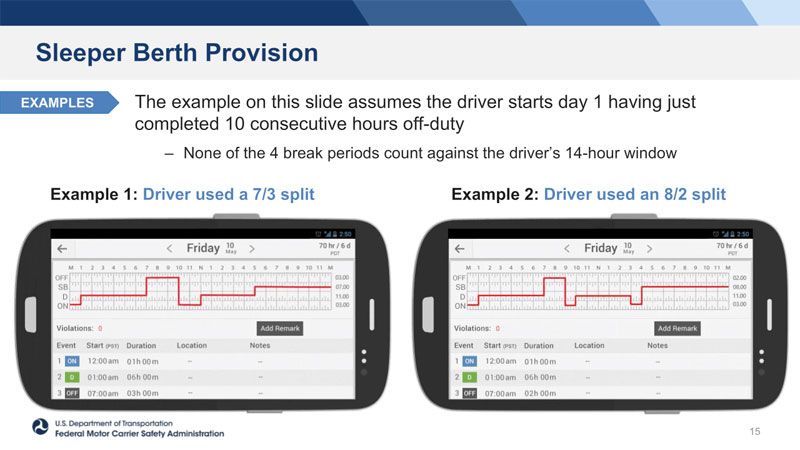First published by FMCSA.
The time has come. Beginning on Tuesday, Sept. 29, the Federal Motor Carrier Safety Administration’s changes to the hours-of-service regulations go into effect.
Aimed to ease some of the rigidness of the regulations, FMCSA made four changes to the rules that the agency said are intended to give truckers more control in determining when it is safe to drive.
Short-haul exception
The new hours-of-service rules expand the short-haul exception to 150 air miles and allows a 14-hour work shift to take place as part of the exception.
“Under the previous rule, a driver based in Peoria, Ill., could not service Chicago and St. Louis,” FMCSA wrote. “The new rule allows the driver to service those two cities, as well as an additional two hours to do so.”
To use the short-haul exception, a driver must start and end the shift in the same location.
Adverse driving conditions
The exception expands the driving window during adverse driving conditions by as much as two hours.
The revised definition of “adverse driving conditions” is snow, ice, sleet, fog or other adverse weather conditions or unusual road or traffic conditions that couldn’t be reasonably known to a driver before the start the on-duty period or immediately after a rest period, and to a motor carrier before dispatching the driver.
FMCSA provided an example of a driver that is 15 miles from his destination when there is a gravel spill on the bridge ahead and the bridge is the only access to the destination. In the example, the driver has one hour left of driving time and one hour left in the driving day. Under the new provision, the driver can stop at the next exit (for up to two hours) until the road is clear and still have time to get to the destination without violating hours-of-service rules.
The agency advises drivers to make an annotation in their electronic logging device when utilizing the provision and to include details about the adverse driving condition.
30-minute break requirement
The new hours-of-service rules did not eliminate the 30-minute break mandate after eight hours of driving, but they do allow the break to be fulfilled through 30 minutes of on-duty, nondriving time. The change means that instead of taking the break off duty, the trucker can now take the break while getting fuel or while completing a maintenance check.
FMCSA emphasizes that under the change, drivers can either satisfy the break off duty, in the sleeper berth, or on duty while not driving. The 30-minute break can’t be broken down into increments.
Sleeper berth provision
The new rules modify the sleeper berth exception to allow drivers to take their 10 hours off duty in two periods, provided one off-duty period (whether in or out of the sleeper berth) is at least two hours long and the other involves at least seven consecutive hours spent in the sleeper. Neither period counts against the maximum 14-hour driving window.
The split could be 8/2, 7/3, or even 7.5/2.5.
FMCSA provided an example with a driver starting day one having just completed 10 consecutive hours off duty. In the example, the driver is on duty from midnight until 1 a.m. and then drives until 7 a.m. The driver then takes a three-hour break until 10 a.m. and goes back on duty until noon before resuming his drive until 5 p.m. Then the driver goes into the sleeper berth from 5 p.m. until midnight. In this example, the trucker had 11 hours of driving time and the break periods did not count against the driver’s 14-hour window.

FMCSA video
FMCSA created a video to explain the rule changes that can be found here.
“The main part of this rule is to provide flexibility to drivers in how they schedule their days to be most efficient, safe and productive in their activity each day,” Joe DeLorenzo, FMCSA’s acting associate administrator of enforcement, said in the video.
FMCSA provides a series of questions and answers regarding the new rules here.
Opposition
The new hours-of-service rules are poised to go into effect despite a recent lawsuit from the International Brotherhood of Teamsters and a coalition of safety groups.
On Sept. 16, the groups filed a petition for review of FMCSA’s final rule in the U.S. Court of Appeals for the District of Columbia Circuit. Before filing the lawsuit, the groups petitioned the agency to reconsider the final rule, calling it “flawed.” FMCSA denied the petitions, emphasizing that the rule changes did not provide additional driving time.
McCraren Compliance can help you understand and comply with FMCSA, DOT and ADOT and ensure your drivers and your vehicles operate safely and efficiently.
Call us Today at 888-758-4757 or email us at info@mccrarencompliance.com to schedule your free FMCSA Compliance Assessment.


